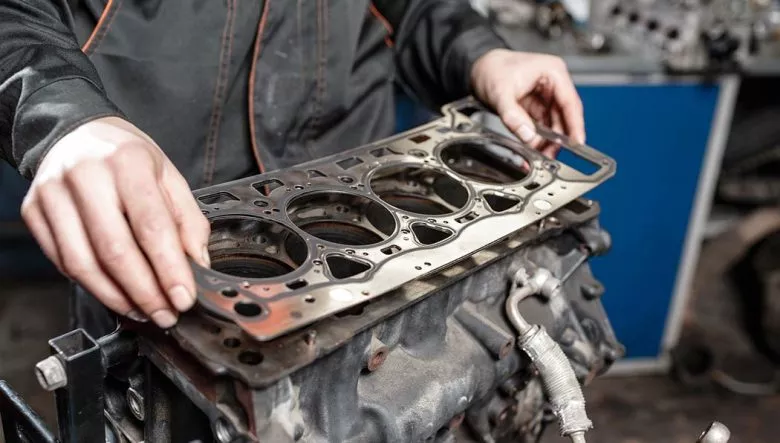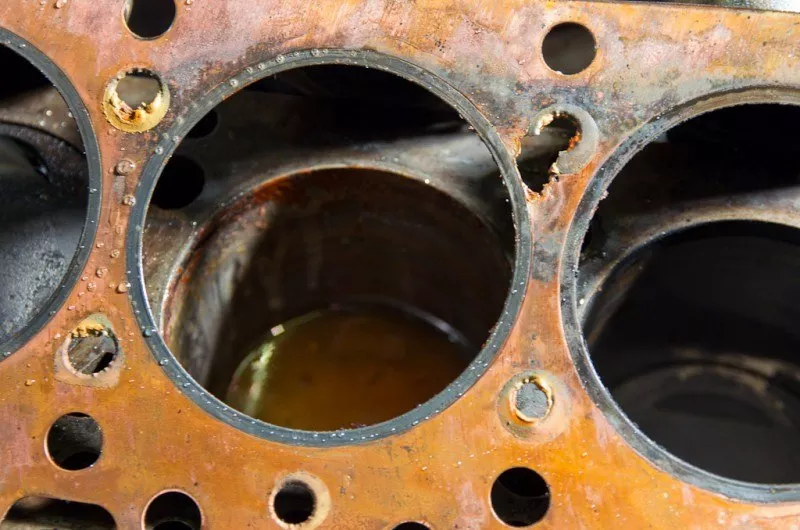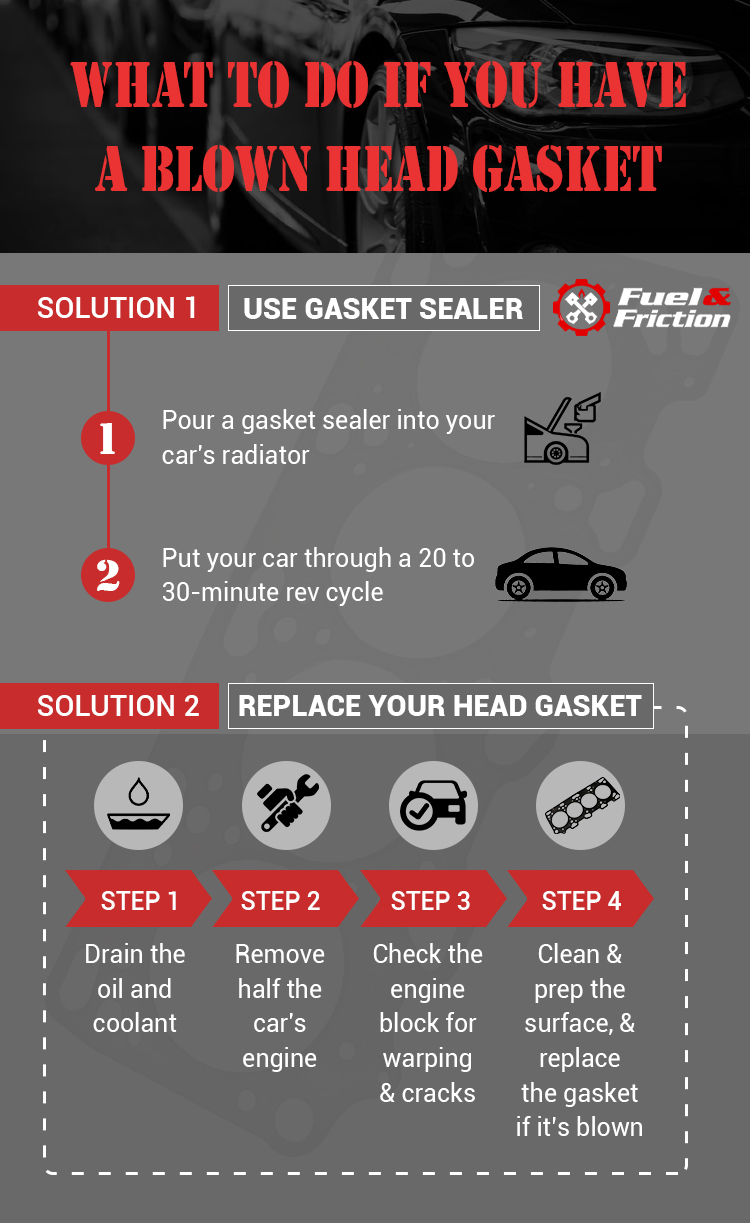What to Do If You Have a Blown Head Gasket
Blowing a head gasket is bad news. On the list of things that can put your car out-of-commission, this is near the top. Luckily, a blown gasket isn't always a precursor to a totaled car and insurance check. With a little education, you might be able to navigate this unfortunate breakdown.
It's essential to recognize the signs of head gasket failure. If you spot the damage early, you can delay or deter the eventual breakdown.
Think of your car's engine as a pump, with the piston pushing things to the top of the engine, or head. The head gasket is the seal that ensures nothing leaks out the sides. By itself, it looks like a thin piece of material with a bunch of holes in it. Once installed, it sits between the engine block and head. It's under a lot of pressure from hardware and the combustion cycle of the engine.
If the head gasket breaks, oil and fluid from the engine's bottom end — the place where the pistons live — can get into the valves. These valves are designed to let air and exhaust fumes in and out of the combustion chamber. They don't take kindly to extra oil in the mix.
Those who drive electric cars don't have to deal with this issue, as the vehicles don't have engine blocks, cylinder heads or head gaskets. With no part, there's no chance of a problem.

Head Gasket Allowing Coolant to Leak into Oil

New Head Gasket Being Installed
Your car's head gasket can fail in a variety of ways. If you suspect a busted piece, there are multiple signs to look for. The easiest symptom to spot is also the most fatal — a warped or cracked cylinder head. This issue results from pressure differentials that are too great. When the gasket fails, you'll need to replace your engine — or at least part of it.
It can be challenging to spot tiny cracks, some of which are invisible to the human eye. At repair shops, technicians find cracks with dyes and pressure tests. Some leaks emit a white, frothy residue around the top of the engine. This residue develops when air mixes will oil, becoming viscous to the touch. This coolant may be hot to the touch — take caution if you want to clean it up. If you notice a leak, check the radiator cap and reservoir.
Cylinder misfire on startup or during operation can indicate a failed head gasket. While driving, look for blue exhaust coming from the tailpipe. This type of smoke is also the result of other failed engine internals, such as faulty piston rings. If you notice a problem, ask a trusted mechanic to investigate further.
Does your vehicle overheat? If so, this is another symptom of a blown head gasket. First, however, check your car's thermostat and cooling system. If the problem occurs, take a look at the engine.

Cracked Cylinder Head in the Valves Area making valves not able to seal perfectly
If you're driving and suddenly notice a misfire — or the engine sounds funny — pull over and stop the car. Driving with a blown head gasket is an easy way to make things worse.
It's best to have your car towed to a mechanic to investigate the part's integrity. If you have coverage through insurance or another organization, now is the time to call. Once a professional checks your car, you'll have several options for how to proceed.
Use Gasket Sealer
The cheapest method to keep your car on the road is to plug the leak with a gasket sealer. A professional-grade formula contains antifreeze compatible sodium silicate sealing liquid, along with gasket sealing particles reinforced with Carbon Fiber. You pour this material into your car's radiator. Then, follow the instructions to put your car through a 20 to 30-minute rev cycle. This cycle ensures the sealant circulates through the engine and penetrates the cracks.
The right formula will dry to form a seal that's stronger than the original part itself. It will also stop all coolant leaks in gaskets, plugs, intake manifolds, engine blocks, aluminum radiators and more.
Several sealants are available on the market. However, it's recommended to choose one from a reputable brand. Since the product is made to circulate throughout your engine's water jacket, a poor quality material can have negative impacts on the cooling system. If you want an option that will stand the test of time, look for a product with reinforcing fibers. In some cases, sealant can last longer than if you completely replace the head gasket.
Replace Your Head Gasket
In some cases, there's too big a leak to use gasket sealant. Talk with a trusted mechanic about a new part to fit your engine. Luckily, the head gasket is one of the cheaper pieces on your car. Unfortunately, you'll still have to pay a decent amount to get it installed — unless you have some car know-how.
To replace the head gasket, you'll first have to drain the oil and coolant. Then, you'll need to remove half the car's engine. The small pieces have a precise place. If you're inexperienced, the wrong move can lead to big consequences. Mechanics tend to catalog each piece they removed. Once all parts are off, the technician will check the engine block for warping and cracks. If they find none, it's time to clean and prep the surface.
Blown Head Gasket? Here's What to Do
When the new part is in place, your car will run smoothly again. If you continue to see signs of poor performance, let your mechanic know. The gasket may be faulty, or another issue might appear.
Are you having trouble with your vehicle's head gasket? Share your story below. How did you diagnose and resolve the problem? Did you fix it yourself and find guidance from a professional? Share your tips and tricks below.

Head gasket failing after overheating. No visible leaks but poor running engine
Scott Huntington is an automotive blogger who covers everything from the Model T to the Model 3. Find his work on Off The Throttle or check him out on Twitter, @SMHuntington

About the Author
Tech Guy
Automotive enthusiast, passionate about Jeeps, hot-rods, turbos, performance, efficiency, diesels, fuels, high performance oils, additives and anything with an engine.

